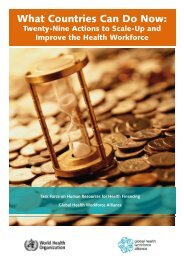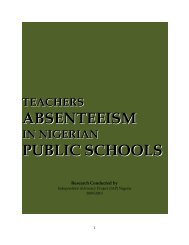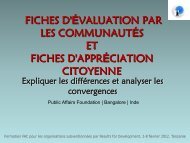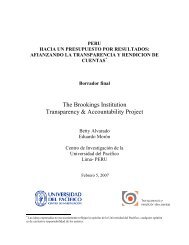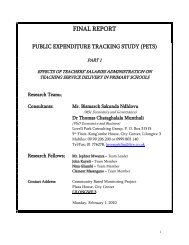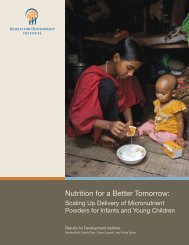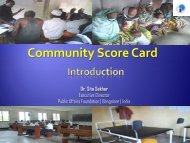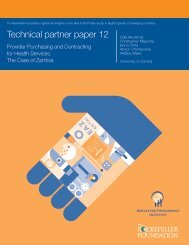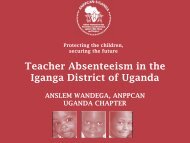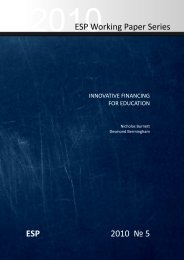Innovative Secondary Education For Skills Enhancement
Innovative Secondary Education For Skills Enhancement
Innovative Secondary Education For Skills Enhancement
You also want an ePaper? Increase the reach of your titles
YUMPU automatically turns print PDFs into web optimized ePapers that Google loves.
nies at 50 percent reduction through a ministry agreement<br />
with the companies.<br />
Sustainability remains in question as funding from USAID<br />
will end with new agency program priorities, and despite<br />
the government’s commitment to the approach, a funding<br />
partner is needed for the continued implementation of<br />
the program. The project is developing a private sector<br />
foundation that will be dedicated to sustaining the public–private<br />
partnerships established in support of pre-K–<br />
through–12 education in Senegal.<br />
Scale and Impact. The program has to date reached 233<br />
schools and affected more than 93,000 students in 10<br />
of 14 regions in Senegal. Results from a rigorous impact<br />
evaluation, including student testing, will be available in<br />
fall 2012. However, early qualitative results show that<br />
teachers report spending more time planning their lessons<br />
using the curriculum guides, researching new materials<br />
on the Internet, and introducing more interactive teaching<br />
strategies in their classrooms.<br />
Ghana <strong>Education</strong> Trust<br />
Fund (Ghana)<br />
To meet the growing needs of the education sector,<br />
governments in Africa are exploring innovative financing<br />
mechanisms for state-led education initiatives. <strong>For</strong><br />
example, the Ghana <strong>Education</strong> Trust (GET) Fund, established<br />
in 2001, is financed by a 2.5 percent additional levy<br />
on VAT as well as returns on investments and voluntary<br />
contributions. The objectives of the fund include raising<br />
enrollment rates in all cycles of the education system;<br />
increasing demand for education at all levels; redressing<br />
the declining public sector spending on education; and improving<br />
overcrowded and decrepit infrastructure, as well<br />
as replacing obsolete textbooks and equipment.<br />
The GET Fund has supported a number of infrastructure<br />
projects in the tertiary and upper secondary sectors—with<br />
a particular emphasis on improving skills training polytechnics<br />
and teacher training colleges. It has also funded<br />
scholarships for students to assist their participation in<br />
university and upper secondary schools.<br />
Innovations to Transform<br />
Existing Systems<br />
Many innovative models in Africa are working to transform<br />
the system by providing complementary or alternative<br />
educational opportunities that improve student access<br />
and learning outcomes. Complementary approaches<br />
include the Ghana President’s Special Initiative on Distance<br />
Learning (PSI-DL), which was established in 2002<br />
to bridge gaps in access by broadcasting secondary school<br />
lessons through the Ghana Broadcasting Corporation’s<br />
(GBC’s) television network. The PSI-DL has also recently<br />
established a stream dedicated to technical and vocational<br />
education and training (TVET) programs, providing both<br />
technical skill lessons and remedial courses in general<br />
education to ensure students are capable of participating<br />
in advanced courses. Also in Ghana, television and radio<br />
programs such as the GBC’s Everyday English program<br />
and the JoyFM Read 100 Project aim to improve language<br />
and literacy levels at the secondary level. These programs<br />
are free, open-access programs that are not linked to<br />
formal examination schedules and instead aim to augment<br />
existing educational programs.<br />
Open and Distance Learning<br />
Schools (Namibia And Botswana)<br />
In addition to complementary approaches, many countries<br />
in Sub-Saharan Africa have introduced a range of open<br />
schooling and distance learning programs to provide alternative<br />
delivery of secondary education and skills training<br />
to students in remote rural areas or to students who wish<br />
to continue their studies in a more flexible program. Some<br />
of these programs are now well established and delivering<br />
at scale. <strong>For</strong> example, the Namibia College of Open Learning<br />
(NAMCOL) was established in 1997 and now graduates<br />
28,000 students annually, accounting for 40 percent<br />
of the country’s secondary school students. The Botswana<br />
College of Distance and Open Learning (BOCODOL)<br />
adopted a similar model in 1998 and now has an annual<br />
enrollment of more than 6,000 students, accounting<br />
for approximately 17 percent of secondary examination<br />
graduates nationally (Daniel 2010).<br />
Approach. NAMCOL uses a blended-learning approach<br />
that combines self-instruction materials with face-to-face<br />
support in weekly tutorials. BOCODOL teaches the national<br />
curriculum, and students sit the same examinations<br />
as their counterparts in the mainstream school system.<br />
Pass rates at the senior secondary level are similar to those<br />
of full-time students at more than 90 percent.<br />
Impact. Pass rates at both NAMCOL and BOCODOL<br />
are comparable to those of the conventional schooling<br />
systems in each country. However, examination grades<br />
at NAMCOL are lower than the equivalents in full-time<br />
schooling, with only 9 percent of part-time grade 12<br />
candidates achieving grade C or above compared with 21<br />
percent in the mainstream system. The government of Namibia<br />
has put in place a quality improvement program to<br />
address this issue. The main constraint on student completion<br />
of examinations at BODOCOL is the very high level<br />
of the examination fee rate, which amounts to 10 times<br />
the cost of tuition.<br />
40 <strong>Innovative</strong> <strong>Secondary</strong> <strong>Education</strong> <strong>For</strong> <strong>Skills</strong> <strong>Enhancement</strong> (ISESE)



